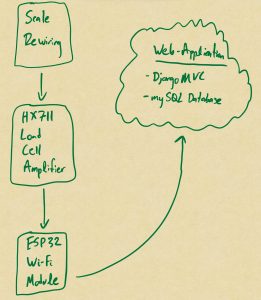With the interim demo coming up on April 1st, coming out of Spring break with a clear plan of attack was important for our group. We spent this week planning out some of the main features we would like to highlight for the interim demo; furthermore, with a realization that the interim demo is a presentation of an intentionally incomplete product, we spent some time deciding how the features we decide to demonstrate will interact with one another.
Surya continued work on scale integration and helped Grace tidy up the web application. In addition, he developed potential approaches to scale integration through a block diagram as seen below:

Scale integration can be done either by hacking into a scale and forwarding values through a microcontroller, or through an OCR on the digital scale reading panel. In evaluating the first option, a strong understanding of scale hardware is required before it can be opened up. The main aspects he focused on were the difference between strain gauges and load cells, how and why they are configured in a Wheatstone arrangement, and the rewiring necessary to forward the load cell measurement through an amplifier and into a microcontroller such as an Arduino.
Given the delicacy of this process and the surprising nuance of hardware behind camera scales, he discerned that an OCR model reading the segmented display panel of the scale may be cleaner to implement for an MVP. This, however, presents its own challenges. Images require more memory to deal with than a stream of bits representing scale readings, so latency becomes a pronounced issue. Furthermore, the accuracy of digit classification is an additional factor that is simply not a problem when one is simply forwarding bits to and from components. The counterargument to this approach is the reduced potential of damages, and for the sake of the MVP and wanting an operational scale as first priority, this is a significant consideration to keep in mind.
In either case, because both options are largely cost-effective, Surya began ordering parts common between both approaches and plans to get his hands dirty with both approaches to see which method works better for the application over the next 2 weeks. He encourages readers to view his weekly status report for more details on the above design plan for scale integration.
Steven made significant progress in testing various ML methodologies. He was able to determine that soft-margin SVMs was not effective enough to include in our implementation. However, the SVMs have provided nice decision boundaries that we plan to use for our backup option: AdaBoost Algorithm. This algorithm establishes weights for varying decision boundaries, so it takes into account multiple boundaries. He was able to research the math and coded up the preliminary functions to compute the weights and train the model.
Steven also shifted a lot of focus into working with GoogLeNet and working with a k-nearest neighbors approach to boost the accuracy of the algorithm in the classification of different fruits. He plans to work on testing next week as well as validation. We hope to have all this tested, and the results analyzed in no more than two weeks. However, another goal next week is to integrate the GoogLeNet classification algorithm directly into the website without any modifications to test the compatibility as well as the preliminary accuracies and latencies.
Regarding progress in integration, Steven did research on ChatGPT4. We are currently hesitant on purchasing the API to save some money. However, Steven wrote the pseudocode for integrating it into the front-end. Likewise, he looked into creating formatted responses given images and formatted inputs. Steven will also begin shifting focus away from local testing on his MacBook Camera and work closely with Surya and Grace to take Arduino or Rpi images and/or images from the website.
Grace was able to take this week’s ethics assignment and apply it towards public safety and public welfare considerations. We realized food tracking applications could induce negative side effects for users with high self-discipline, so an additional globals page could help promote a body positive environment that shows users what others are up to as well. A caption can also be added so our web application is used more as a social media, but of course this is optional for users and they can always choose to opt-out. With this potentially being more on a global scale, I want to consider larger options for file uploads to be able to accommodate this. One option is instead of using the web application’s file system, a content delivery network could be used since their servers are scattered around the world. This would definitely help improve speed and performance of our web application in the long-run.
